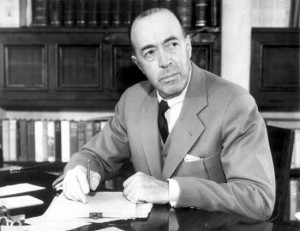
Edgar Rice Burroughs
I’ve written a great deal about my muse, Edgar Rice Burroughs, and how as a kid I read just about all of his seventy-plus novels. His adventure stories both on (and in) Earth—Tarzan, Pellucidar, Caspak—and on other worlds—John Carter of Mars, Carson of Venus—sparked my imagination and led to a long and prolific writing career.
But as a kid I could not appreciate the nuances of his three-book Moon series, which consisted of The Moon Maid, The Moon Men, and The Red Hawk. Because back then, what could I know about the evils of Communism?
AN ALTERNATE HISTORY
In 1919, about the time ERB began to enjoy much fame—and later, fortune—with his Tarzan and John Carter books, he wrote a story called Under the Red Flag to express his dislike and mistrust of Communism. The story, set in Soviet Russia, featured the Bolsheviks as bad guys. But his publisher nixed any deal; this was not what his fans would want. Later on he found another use for this story, which I’ll get to shortly.
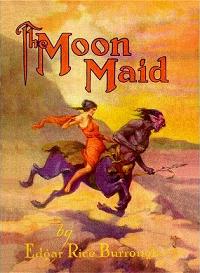
An old cover of The Moon Maid.
In 1922 ERB wrote The Moon Maid. The main story itself was more like what his fans and his publisher expected. But the prologue to the story, which takes place in the late 1960s, included a thought-provoking alternate history in which World War had raged unbroken until just before the start of the narration. Now, with peace prevailing, the world is looking to the stars, specifically to Barsoom (Mars), home to ageless Earthman John Carter. The nameless intermediary is listening to a man named Julian, who can, he says, recall all of his reincarnations, past and present. The first Julian fought and died at the Battle of Argonne Forest in 1918. The story that the intermediary will hear comes from Julian 5th, who was born in the year 2000.
THE MOON MAID
This first book in the series was the most familiar and formulaic to ERB fans. After updating the reader about the state of the world through the first quarter of the twenty-first century—a small, International Peace Fleet owns all of the weapons on the planet, as there are no internal threats—Julian 5th talks about Earth’s desire to send a ship to Mars. After a failed attempt in 2015, a solar ray is discovered by a former classmate of Julian’s, Lt. Commander Orthis, whom he describes as “brilliant, unscrupulous, and obnoxious.” He seems to have an ongoing hatred of Julian 5th, who outranks him. With the application of the solar ray a spaceship called the Barsoom is launched in 2025. Julian is the captain, Orthis one of his assistants. Need I say that the ship never makes it to Mars?
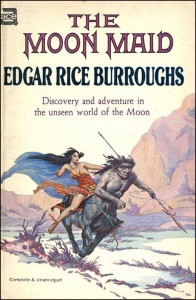
The Moon Maid, Ace edition.
More conflicts between Julian 5th and Orthis cause the latter to sabotage the ship, and it winds up barely making it to the Moon. There, deep inside a crater, an underground world teeming with life is discovered, and the formulaic sword & planet adventure begins. A breathable atmosphere (of course), strange flora and fauna, odd races of humans and humanoids, and the necessary gorgeous woman (a princess, naturally) with whom Julian will fall in love.
A QUICK SYNOPSIS
Julian 5th is within his rights to have Orthis executed, but instead he spares him, a decision that he will regret for hundreds of years to come. While the rest of the crew works on the damaged ship, Julian and Orthis hunt for food. They are captured by the Va-gas, a nasty race of centaur-like, cannibalistic beings. Orthis ingratiates himself with the chief, while Julian escapes with Nah-ee-lah, the aforementioned gorgeous female, daughter of the ruler of Laythe. Their harrowing trek across the moonscape includes deadly encounters with the Kalkars, an indolent, brutish race that despises the Laytheans. They call themselves Thinkers but are in fact lazy assholes who live off the labor of slaves.
Eventually Julian and Nah-ee-lah wind up in Laythe, and much later the city is attacked by the Kalkars, who have advanced weaponry way above the sword, spear, and bow & arrow of this world. Yep, good old Orthis (now called Or-tis by the Kalkars) found his way to this nasty race and gave them the new power, all because of his hatred for Julian 5th. Laythe is destroyed, but Julian and Nah-ee-lah slowly make their way back to the ship, which has been repaired and is ready to head back to Earth—more than ten years after landing inside the Moon. Wow, time flies in a land of eternal daylight! End of story.

The Moon Men, Ace edition–my copy.
THE MOON MEN
Remember Under the Red Flag, ERB’s story about living under the yoke of Communism? Well, with a few tweaks, ERB turned it into The Moon Men—same basic story, but now a sci-fi novel that takes place in the twenty-second century. In the opening chapter the intermediary again encounters Julian, and he offers to tell the story of Julian 9th, though first he updates what happened to Julian 5th. He and Nah-ee-lah were wed here on Earth, and she gave birth to Julian 6th. In 2050 Earth was invaded by the Kalkars, who arrived in spaceships designed by their leader, Lt. Commander Orthis. Julian 5th had tried to warn the two primary governments in Washington and London about this possibility, but they scoffed at him. Now, with the International Peace Fleet all but emasculated, The Kalkars take over the Earth. Julian 5th and Orthis meet in a final battle, and both are killed.
Julian 9th, twenty years old, lives in a semi-feudal district near Chicago—or what is left of it. The Kalkars—ERB’s Communists—rule what used to be called America. Religion is banned—although Julian and his parents worship with others in secret—people are taxed beyond reason for what crops they grow or animals they raise, including bribes to corrupt petty bureaucrats, and are constantly threatened with death or imprisonment. Julian’s parents hold on dearly to an American flag, one that the first Julian flew at the Battle of Argonne Forest two centuries earlier. People are ratted on by their neighbors in attempts to curry favor with the Kalkars. All in all it is a miserable life for Julian 9th, at least until he meets Juana and falls in love. Their district is ruled by Brother (Comrade) General Or-tis, a descendant of Orthis, who first brought this hell upon his own world.
Ultimately, Julian 9th has just about had it with the whole thing, especially after a neighbor snitches about their worship services, a good friend is murdered, and his father, Julian 8th, is imprisoned. By this time he and Juana have wed (secretly; marriages have been banned by the Kalkars). Breaking his dad and a lot of other people out of prison, Julian 9th leads a revolt against the oppressors. Under the banner of Old Glory they kill many of their enemies, and Julian destroys Or-tis as he attacks Juana. But inevitably, his parents fall, and Julian 9th is captured and led to the Butcher—the Kalkar executioner. His death assures his martyrdom. End of book two.
THE RED HAWK
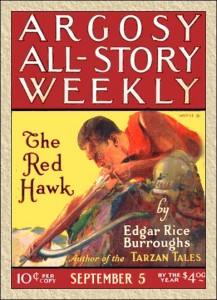
The Red Hawk, original pulp magazine cover.
The shortest of the three stories, The Red Hawk is more of a novella. Through the years it has been published as a stand-alone book or as part two of The Moon Men. My old Ace edition of The Moon Men was published that way. There is no prologue to this story, just the narration of Julian 20th more than three hundred years after Julian 9th. By this time the Americans—what remains of them—have adopted a nomadic tribal life—yes, they have become Indians, and Julian 20th is the Chief of Chiefs. Over the centuries they have driven the Kalkars toward the western ocean, until all that is left of the House of Or-tis—still a formidable force—occupies the coast of California. (At least they recognize prime real estate.) The Americans fight under the flag of the first Julian at the Battle of Argonne Forest, although the flag’s actual meaning has long been forgotten. Julian 20th and the other tribes are preparing for what he hopes will be the final confrontation against the descendants of the invaders from the Moon.
I’ll stop my narration here, in case you are curious enough to read this fascinating series by a master storyteller. I will say that the ending, though unexpected, made a lot of sense to me, and proved quite satisfying. Although Edgar Rice Burroughs wrote many stories that were more popular, a number of critics and biographers consider this his finest, most thought-provoking work. I cannot disagree.
Read more about ERB. See my posts, “Thank You, Edgar Rice Burroughs,” and “Edgar Rice Burroughs: The Master Of Lost Worlds.”
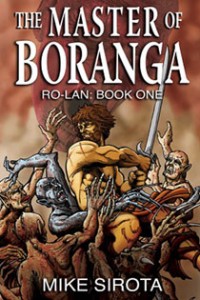 A PRACTICAL WAY TO HONOR THE MASTER
A PRACTICAL WAY TO HONOR THE MASTER
ERB’s influence caused me to put my butt in the chair and write The Master of Boranga, my first book, in the late seventies. It was published by Zebra Books back then, and a few years ago I reissued it in Kindle eBook and paperback. Beginning today, August 3rd, through Wednesday, August 5th, the eBook will be available for the whopping sum of .99¢. You’ll definitely see ERB’s impact in these pages. Enjoy!

I love reading about who inspires other writers. My author/mentor is Thomas Harris. I’ve studied the plotting of Red Dragon many times. And when I read his other books, I often stop and ask myself, “How did he do that?” Of course he tends to take 8-10 years to write a novel, so I suppose it better be damn good! Still, I love learning from his work…
I used RED DRAGON as a teaching tool. It is one of the most well-plotted books EVER.